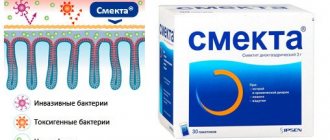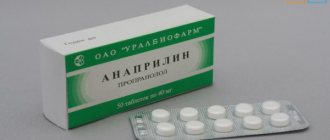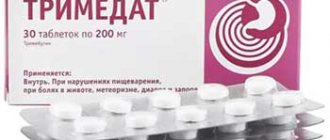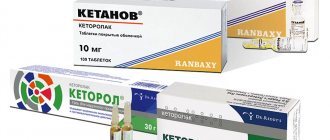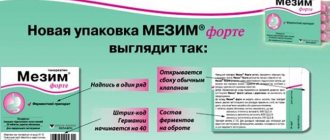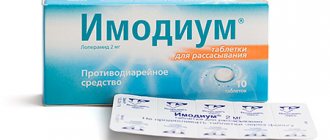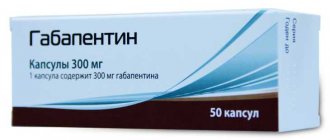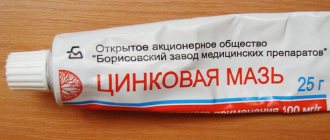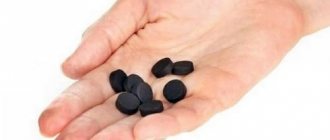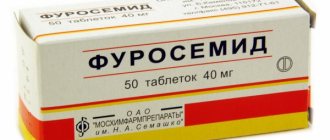Contraindications for use
The main contraindications for the use of children's "Diazolin" include the following pathologies:
- The presence of peptic ulcers of the stomach and intestines, as well as the presence of inflammatory diseases of the digestive system in the acute stage. This is directly related to the fact that this medical drug, when it enters the child’s body, somewhat irritates the mucous membrane of the stomach and intestines, including.
- Development of intolerance to individual ingredients that are part of this medication.
- The child is up to two years old.
- In the presence of closed-angle glaucoma.
- Against the background of prostatic hypertrophy.
Side effects
The use of Diazolin may cause the following side effects:
- Hematopoietic system: in rare cases - agranulocytosis, granulocytopenia.
- Central and peripheral nervous system: possible paresthesia, dizziness, tremor, fatigue, slow psychomotor reaction, drowsiness, anxiety (at night).
- Digestive system: rarely - dyspeptic symptoms as a result of irritation of the gastric mucosa (in particular, attacks of nausea, heartburn, pain in the epigastric region), dry mouth.
- Urinary system: in rare cases - dysuria.
Analogues of the drug
Like many other drugs, Diazolin has several analogues.
Complete analogues are Omeril and Dialin, but they are not available in every pharmacy.
Omeril is prescribed to children over 2 years of age for skin allergies or allergies to medications. Dialin copes well with urticaria, conjunctivitis, and rhinitis.
One of the analogues of Diazolin is Diphenhydramine: it is dispensed from pharmacies only with a prescription.
It causes drowsiness and gastrointestinal disorders. This remedy is not used to treat allergies in children.
Another analogue is Suprastin; unlike Diphenhydramine, doctors prescribe it for children to treat allergies. The cost of this product is an order of magnitude more expensive than Diazolin, it also causes drowsiness.
Also, instead of Diazolin, a specialist may prescribe Tavegil, which is positioned more as a sedative than an allergy drug.
The medication has a strong sedative effect; after using it, it will be difficult for the child to concentrate on anything, and this may have a negative impact on his studies.
Overdose
Does the instructions for use contain information regarding overdose and contraindications for taking the drug “Diazolin for children”? The specialists developing the drug state in the annotation that when the drug is used exclusively in recommended doses and with the correct time interval between doses, the drug is well tolerated. An overdose can only occur if the described dosage regimens and rules are not followed and can manifest as pronounced side effects. In such cases, measures are taken to lavage the stomach, treatment is stopped and a doctor is immediately consulted for advice on further therapy.
Indications and contraindications
This medication has a wide spectrum of action, and doctors prescribe Diazolin tablets to children for diseases such as:
- Rhinitis.
- Swelling of the respiratory tract.
- Food allergies.
- Seasonal allergies.
- Insect bites.
- Flu.
- ARVI.
- Pathologies of the thyroid gland.
- Pathologies of the liver and kidneys.
Diazolin is contraindicated for children who suffer from diseases such as:
- Gastritis, in which erosions form.
- Hypersensitivity to substances contained in the drug.
- Duodenal ulcer.
- Various pathologies of the gastrointestinal tract.
Also, the medicine should not be taken by those patients who suffer from epilepsy, severe disorders in the central nervous system, arrhythmia, eye diseases (increases eye pressure).
https://youtube.com/watch?v=2Fs7bBDqTKg
Side effects of the medicine
Diazolin relieves symptoms of food and seasonal allergies well, as well as irritation after insect bites, but do not forget that it can also cause a number of side effects.
In some cases, after taking the medication you may experience:
- Fatigue.
- General weakness.
- Drowsiness.
- Heartburn.
- Dry mouth.
- Deterioration of vision.
- Skin rash.
- Itching.
- Frequent urination.
- Dizziness.
- Nausea.
- Vomit.
- Pain in the solar plexus area.
- Hyperactivity.
- Insomnia.
- Trembling of limbs.
The required dosage of Diazolin for children is prescribed only by the attending physician; it is very dangerous to give the baby medicine without a prescription from a specialist.
Dosage and Application
At what age can Diazolin be given to children? It is not recommended to give Diazolin to children under one year old; it is prescribed to babies only if the doctor considers that taking other drugs with a gentler composition will not have the desired effect.
Most allergists try not to prescribe Diazolin for the treatment of allergies in children under three years of age.
This medication is taken 3 times a day before or after meals. The Diazolin tablet is swallowed without chewing and washed down with a glass of water. The duration of the medication course is agreed upon with the treating specialist.
Children under 2 years of age are given the medicine no more than twice a day from 50 to 100 mg, children from 3 to 5 years old are given half a tablet twice a day, those children from 5 to 10 years old are given half a tablet three times a day. , adolescents over 13 years old - half a tablet 3-4 times a day.
This medicine is prescribed to children for insect bites, bronchial asthma, and as a prophylactic before vaccinations.
The drug is also suitable for the treatment of ARVI, as it destroys allergens accumulated on the mucous membranes of the child’s nose and throat.
For chickenpox, the medicine reduces the desire to itch, as it perfectly eliminates itching.
Directions for use and dosage for children
According to the instructions, Diazolin is prescribed to children over 3 years of age in the form of tablets or dragees, and in the form of a suspension - from 2 years of age. The drug is taken during or immediately after a meal, swallowed whole, without chewing - this is necessary to reduce the irritating effect on the intestines and stomach walls. The medicine should be taken with a small amount of water.
Suspension
To prepare the suspension, add 100 ml of boiled water to the bottle and mix thoroughly until the granules are completely dissolved. The resulting mixture must be shaken before each use.
Suspension dosage for children:
| Child's age | Volume, ml | Frequency of reception |
| 2-3 years | 2,5 | Depending on the severity of the disease – 2-3 times a day |
| 4-6 years | 5 | |
| 7-10 years | 7,5 |
Pills
When it is difficult for a child to swallow a tablet or dragee, it is convenient to use a suspension. However, not everyone will like its taste, and many find it easier to swallow the pills than to drink the liquid form of the medicine. Dosage of Diazolin in tablets:
| Child's age | Dosage | Frequency of reception | |
| 50 mg | 100 mg | ||
| 3-6 years | 1/2 table | – | 1 to 3 times a day |
| 6-12 years | 1 table | – | |
| over 12 years old | – | 1-2 tables | |
As can be seen from the table, for children under 6 years of age it is more convenient to use Diazolin 50 mg. If the pharmacy does not have the required dosage, instead of 50 mg, you can give the child half a 100 mg tablet and vice versa, independently calculating the required number of tablets.
The duration of treatment varies depending on the disease and its severity. Reception can be one-time or systematic, usually from 3 to 7 days. Diazolin should not be taken for more than 10 days, as it is addictive.
If longer-term use is necessary, the drug is replaced with a similar antihistamine.
Indications for use
To prevent or treat allergic reactions, the drug Diazolin is usually used. The indications for the use of this medicine are quite diverse. Doctors prescribe it for the following diseases:
- vasomotor rhinitis;
- hay fever (or hay fever);
- hives;
- conjunctivitis and allergic rhinitis;
- atopic and contact dermatitis;
- drug allergies;
- Quincke's edema;
- skin reactions after the bite of non-poisonous insects.
Despite the fact that this medication is tolerated quite easily by patients, there is always the possibility of side effects. Therefore, Diazolin tablets or dragees are practically not used for the treatment of chronic allergic diseases. Its main purpose is to eliminate the symptoms of an acute allergic reaction at the earliest stage.
When can the product be used?
The drug is most effective against allergies caused by food and drugs.
The main indications are:
- developing urticaria;
- allergic conjunctivitis in the active phase;
- itchy dermatoses;
- dermatoses with painful rash;
- hay fever;
- rhinitis (chronic or seasonal);
- bronchial spasms;
- allergic reaction to insect bites;
- serum sickness;
- impaired functioning of the kidneys and liver (should be used with caution, individual dosage selection is required).
Diazolin can also be used for preventive purposes. The frequency of administration and dosage is determined by the doctor.
Analogs
Diazolin has 2 structural analogues - 2 drugs similar to it in composition:
- Mebhydrolin (tablets);
- Mebhydrolina Napadisylate (powder).
The active ingredient of both drugs is mebhydrolin. The mechanisms of action of the drugs, their indications and contraindications, side effects are similar to the characteristics of Diazolin. They are in the same price category.
There are drugs in pharmacies that have a different composition, but have an effect similar to Diazolin:
Zyrtec is a medicine with the main active ingredient cetirizine, produced in the form of drops and tablets. Approved for the treatment of babies from 6 months. It is characterized by fast effectiveness, softness, and safety. Costs on average 320 rubles (drops in a 10 ml bottle).
An analogue of Diazolin is Zyrtec.
- Zodak is a product also based on cetirizine, available in three forms: syrup, drops, tablets. The drug blocks H1-histamine receptors, thereby preventing a number of allergic reactions. In the form of syrup, Zodak is approved for use from the age of 2, in the form of drops - from the age of one. The disadvantage is a fair number of contraindications and side effects. The average price (drops in a 20 ml bottle) is 210 rubles.
- Ketotifen is a drug containing the active component ketotifen fumarate. Produced in the form of tablets (allowed from 3 years of age) and syrup (suitable for treating children under 3 years of age, dosage is calculated based on body weight). It has a large number of side effects and affects the nervous system. Advantage - quickly copes with allergy symptoms. The average price (pack containing 30 pills) is 80 rubles.
- Loratadine is a medicine with the same active ingredient (loratadine), produced in the form of tablets (for children over 36 months and adults) and syrup (for children under 3 years of age). Blocks H1-histamine receptors, acts quickly and effectively. The average price of tablets (10 pieces) is 35 rubles, syrup (100 ml) is 165 rubles.
- Suprastin is a popular drug based on chloropyramine hydrochloride, available in the form of tablets and solution for intramuscular injection. It has an impressive list of possible side effects, including a pronounced hypnotic effect. Costs on average (a package containing 20 pills) 150 rubles.
Diazolin has less pronounced negative manifestations than its analog Suprastin.
- Tavegil is a drug with the main active ingredient clemastine hydrofumarate. In the form of syrup it is approved for the treatment of children over one year old, in the form of tablets - only from 6 years of age. There is also Tavegil in injection ampoules. The product has a large list of possible side effects, however, the risk of their occurrence if the instructions are followed is minimal. The average price of tablets (20 pieces) is 220 rubles.
- Cetrin is a medicine based on cetirizine dihydrochloride. Advantages - it has no sedative effect and acts both at the early and late stages of an allergic reaction. Available in the form of syrup (for treating children over 2 years old) and tablets (only for children over 6 years old and adults). The price of a package of 20 pills is 150 rubles.
- Cetirizine - tablets and drops for oral administration with the main active ingredient cetirizine dihydrochloride. An effective antiallergic and antipruritic agent. The average price of tablets (pack of 10 pieces) is 68 rubles, drops (10 ml bottle) - 245 rubles.
- Erius - syrup and tablets based on desloratadine, which blocks the sensitivity of the corresponding receptors to histamine. It has a high speed of action. The average price of pills (pack of 10 pieces) is 600 rubles.
An analogue of Erius is Diazolin.
Negative phenomena
Is there information about side effects to the drug “Diazolin for children”? The instructions for use state that disorders can be noted in several body systems at once:
- from the digestive system: heartburn, abdominal pain, nausea and vomiting;
- from the central nervous system: fatigue, malaise and drowsiness, dizziness, inhibition and slow reaction, temporary disturbance of visual perception;
- in rare cases, after administration, dry mouth, frequent or, conversely, very rare urge to urinate may be noted;
- There have been cases where taking the drug in children caused tremors, sleep disorders and increased excitability.
Instructions for use of Diazolin tablets for adults
Instructions for Diazolin dragees and tablets
The drug in tablets and dragees is used during or after meals. How to take for adults?
- Children from twelve years of age, as well as adults, use the drug once or twice a day at a dose of 100-200 mg. The maximum single dose for adults should be 300 mg; adults can take 600 mg of Diazolin per day.
- Children five to twelve years old can take 50 mg two to three times daily. Children aged three to five years can take 50 mg of the drug 1-2 times a day.
Children's Diazolin is used as follows: 100 ml of warm boiled water is added to the bottle containing the granules. The contents must be mixed very thoroughly, for which you need to stir for several minutes. After this, the suspension is given to children in doses that can be easily determined using the supplied graduated glass.
The use of Diazolin is contraindicated for:
- Angle-closure glaucoma;
- Prostatic hyperplasia;
- Peptic ulcer of the stomach and duodenum,
- Pyloric stenosis;
- Inflammatory diseases of the gastrointestinal tract;
- Epilepsy;
- Pregnancy and lactation;
- Heart rhythm disturbances;
- Hypersensitivity to the active or auxiliary components of Diazolin.
What is Diazolin
This is a medication that has a sedative, antipruritic and antiallergic effect on the patient. Diazolin tablets contain Mebhydrolin (mnn), an active ingredient. This element acts as a histamine receptor blocker and reduces the likelihood of edema. Diazolin is most often taken for allergies, but the drug also has an anti-exudative effect.
The drug compares favorably with drugs of the first generation of medications in that it does not have a pronounced sedative effect and weakens the effect of histamine on the muscles of the intestines, bronchi, and uterus. The peak effectiveness of the drug is observed 2 hours after administration; the effect may persist for 2 days. The medicine was listed on the Russian radar and is sold in all pharmacies and online pharmacies along with instructions for use.
Indications for use
These tablets are widely popular when it is necessary to relieve the symptoms of a developing cold or allergic reaction. The following indications for the use of Diazolin are distinguished:
- for allergies in a child, starting from 3 years of age;
- Diazolin medicine is highly effective for food allergies;
- in case of an allergic reaction to other medications;
- for the symptomatic treatment of allergic conjunctivitis, rhinitis, urticaria;
- to relieve itching from insect bites, neurodermatitis, eczema, dermatoses;
- relieves the condition, relieves swelling in hay fever, bronchial asthma, serum sickness.
- The most effective antihistamines for children and adults - a list of medications with instructions and prices
- Antihistamines for children and adults
- The drug Eglonil - composition and release form, indications for use, side effects, analogues and price
Contraindications
The medicine is highly effective, but has a number of prohibitions that must be observed. Diazolin - instructions for use contain descriptions of all cases in which the drug should not be taken. This may lead to complications of the condition, disruption of the functioning of certain organs, or to side effects. There are the following main contraindications for Diazolin:
- epilepsy;
- duodenal ulcer;
- pregnancy;
- inflammation of the intestinal walls;
- prostatic hypertrophy;
- heart rhythm disturbances;
- stomach ulcer;
- pyloric stenosis;
- glucose/lactose intolerance;
- atony of the bladder, intestines;
- chronic gastrointestinal diseases in the acute stage;
- angle-closure glaucoma;
- during lactation.
Side effects
When using the medication, it is important to follow the instructions, because violating the dosage can lead to negative consequences. The following side effects of Diazolin are identified, which affect different body systems:
- Nervous system, sensory organs : paresthesia, increased fatigue, dizziness. At high doses, blurred vision, slow reaction, and drowsiness are observed. Children may experience sleep disturbances, irritability, tremors, and increased excitability.
- Digestive system : heartburn, nausea, dry mouth, epigastric pain, dyspeptic disorders, vomiting, constipation, irritation of the gastric mucosa.
- Urinary system – urinary disorders.
- Hematopoietic organs : granulocytopenia, agranulocytosis.
- In the presence of liver and kidney diseases, signs of the toxic effect of the drug may appear, which provokes an increase in the severity of negative consequences. It is necessary to reduce the dosage of use according to the instructions.
special instructions
You should not use this drug without consulting a doctor, increase the duration of treatment and the prescribed dosage, as there is a possibility of negative consequences and a worsening of the disease.
It is strictly forbidden to drink drinks containing alcohol during treatment. It is very important, when taking Diazolin for allergies, to refrain from engaging in potentially dangerous activities that require increased alertness and speed of reactions. This requirement also applies to driving vehicles.
Remember that the active component of the drug can enhance the effects of ethanol and sedatives.
Reviews about the drug "Diazolin"
What reviews does the drug “Diazolin for children” have? Instructions for use, dosage and possible undesirable consequences of taking it are undoubtedly important information, but most parents are interested in the question of how children tolerate the drug. A huge number of mothers claim that thanks to this medicine they were able to overcome diathesis, dermatitis and allergic rhinitis in children during the flowering season of certain plants. All reviews that parents leave about this medicine are mostly positive. Almost everyone notes that they have been familiar with this medication since their childhood, which is why most trust the antihistamine Diazolin. Only a few responses indicate that the medicine was not suitable or caused an even worse allergy. Experts respond to this that such a reaction could be a consequence of individual sensitivity to the components in its composition.
Indications for use of the drug for children
For children, the presented drug is prescribed for allergic reactions and various diseases. For example, this drug is prescribed for allergic rhinitis, inflammation of the conjunctiva, against the background of skin rashes and itching, and for angioedema, which is caused by allergies. The main indications for the use of Diazolin for children are:
- The presence of atopic (that is, congenital) dermatitis. In this situation, the medication relieves itching with tissue swelling and dries out the weeping rash. In such situations, doctors prescribe this drug in long courses.
- For stings of bees, various insects and wasps. Taking this medication in the form of a short course quickly reduces swelling and redness in the bite area.
- For food and drug allergies. The drug "Diazolin" very quickly relieves urticaria with Quincke's edema, which, as is known, occurs as a result of an allergic reaction.
- For hay fever (that is, against the background of hay fever) caused by allergic reactions to plant pollen. Using the drug in fairly long courses makes it possible to eliminate allergic rhinitis along with conjunctivitis, which occurs in children during the flowering period of certain plants.
- For bronchial asthma. In this case, the drug can be used in courses as part of complex therapy as prescribed by a doctor.
The list of indications for Diazolin for children is quite extensive.
Admission rules
How to take the medicine "Diazolin for children"? Instructions for use of 0.05 grams of the active substance in one tablet, namely this dosage for the children's form of tablets and dragees, describes the following recommended doses of the medication:
- children from the age of three can be given 25 mg at a time no more than three times a day, preferably with equal time intervals between doses;
- from 5 to 12 years of age, you can increase the dosage to 50 mg when taken twice a day or increase the frequency of use to 4 times per 24 hours, 25 mg;
- adolescents can take up to 100 mg at a time, but not more than two doses per day, with a time interval of at least 12 hours between doses.
Can infants be given the drug “Diazolin for children”? There are no instructions for use in infants in the annotation. You should consult your pediatrician about the possibility of taking it at such an early age.
Contraindications and adverse events
Before you buy Diazolin, read about its contraindications and side effects. This remedy is prohibited for the following pathologies:
- bowel and/or bladder sluggishness;
- inflammatory processes in the gastrointestinal tract, as well as gastric or duodenal ulcers (the medicine is somewhat irritating to the gastrointestinal mucosa);
- angle-closure glaucoma;
- glucose and lactose intolerance, individual hypersensitivity to the components of the product.
The following conditions are not a direct contraindication to taking Diazolin, but if they are present, particularly careful medical supervision is required during treatment:
- epilepsy and susceptibility to seizures;
- a number of diseases of the cardiovascular system (the drug can increase heart rhythm disturbances);
- pyloric stenosis (a pathology in which the final section of the stomach is narrowed);
- liver and kidney damage.
Typically, children's Diazolin is well tolerated by young patients. Adverse events are rare, but may include:
allergies (most often urticaria);
Side effect: allergies.
- dizziness, lethargy, drowsiness, trembling of limbs, absent-mindedness (or vice versa - sleep disturbances, euphoria, headache);
- urinary disorders;
- dry mouth;
- changes in skin sensitivity.
It is not recommended to take Diazolin together with sedatives (it enhances their calming effect).
Contraindications
Despite the effectiveness of the product, it is not suitable for everyone.
It is not advisable to use Diazolin if:
- individual intolerance;
- gastritis, ulcers and other inflammatory diseases of the stomach and intestines, since the medication stimulates the production of gastric secretions;
- child under 3 years of age (powder is not given to children under 2 years of age);
- heart rhythm disturbances (increased arrhythmia is possible);
- epilepsy or a history of epileptic seizures;
- angle-closure glaucoma;
- prostate pathologies
Taking the medicine together with alcohol is strictly contraindicated . It should be used with caution in case of pathologies of the liver and kidneys. It should be borne in mind that the medication, since it does not act instantly, is ineffective in critical life-threatening conditions - anaphylaxis and Quincke's edema. Hypertensive patients should take it with caution, as blood pressure may increase.
Although the drug does not have a pronounced sedative effect, it is better to play it safe: during the period of use, do not drive a car or do work that requires an immediate reaction and increased attention. If Diazolin is taken together with other sedatives, it will enhance their effect.
Pregnancy and breastfeeding
The drug is not recommended for pregnant women. However, the question of its prescription must be decided by the doctor. If the potential danger for a woman with developed allergies is higher than the harm from the product, then use starting from the 2nd trimester is possible. It is carried out under strict medical supervision. However, if possible, it is better to prefer more modern and safe drugs that have fewer undesirable consequences. During lactation, taking Diazolin is also allowed, if there are no other options, as prescribed by a specialist. But breastfeeding will need to be stopped.
Description and composition
The manufacturer produces the drug in two dosage forms - tablets and dragees. The dosage can be 50 mg and 100 mg.
The dragees are spherical and white in color. The tablets are round in shape and white in color.
According to the instructions for Diazolin, the main component of the medication is mebhydrolin. Dragees, in addition to the active substance, contain auxiliary components: sunflower oil, talc, beeswax, white molasses and sucrose.
The drug is able to have an antiallergic effect and reduce swelling of the mucous membranes.
"Diazolin" stops the effect of histamine on the intestines, uterus, bronchi and other internal organs with smooth muscles. Mebhydrolin reduces the hypotensive effect of histamines and eliminates increased vascular permeability.
The medication does not have a pronounced hypnotic or sedative effect. This is due to the fact that the active component penetrates the BBB in small quantities.
The drug is intended for oral administration. After entering the body, the active substance is quickly absorbed in the gastrointestinal tract. Bioavailability variability is 40-60%. Metabolism of the active component occurs in the liver. As a result, the synthesis of microsomal liver enzymes is enhanced. The active substance is excreted from the body by the kidneys, along with urine.
Characteristics of the drug: composition, action, release form
Positioned as a first generation antihistamine, Diazolin tablets instructions for use. The price of the drug averages 50-100 rubles per package. It is important to consider that the tablets have different dosages: 50 and 100 mg of the active substance, which is mebhydrolin. The abstract reports that a smaller dosage of the medication is intended for the treatment of children.
The action of the drug is aimed at relieving the allergic reaction and providing a sedative effect. Previously it was considered a side effect. Now doctors take advantage of this quality. Dragees and tablets have the ability to block histamine receptors. The medication relieves swelling from mucous surfaces. The drug has a slight anesthetic effect, which is more likely to be additional than primary. Dragees relax muscle tone and affect the functioning of the central nervous system.
What's better
Diazolin or Suprastin
These drugs are often compared by specialists. Diazolin and Suprastin are similar in their action and have a high degree of effectiveness. It is impossible to say which of these drugs is better, since each of them quickly relieves allergy symptoms.
However, doctors advise children to take Diazolin. It is better suited to the child’s body and minimizes the occurrence of side effects.
Children should use Suprastin with great caution, as negative consequences are possible. Suprastin should not be taken under the age of five years.
Diazolin or Claritin
These drugs are often prescribed to children with severe allergy symptoms.
It is difficult to say which of these medications is better, since they do an excellent job of eliminating an allergic reaction. Diazolin is prescribed by doctors more often due to its composition. Substances cause complications extremely rarely. When taking Claritin, the likelihood of complications increases. Usually this drug is prescribed by a doctor in a strictly recommended dosage. If it is violated, negative consequences may occur.
Find out from our article how to treat Giardia in children. What tests can be done to confirm the diagnosis?
Contraindications and side effects
The drug Diazolin has some contraindications:
- intolerance to the active substance – mebhydrolin;
- pathologies of the gastrointestinal tract (ulcers, enteritis, colitis);
- prostate hyperplasia;
- angle-closure glaucoma;
- arrhythmia and epilepsy.
Particular caution should be exercised when prescribing the drug for renal or liver failure. In these situations, Diazolin is prescribed by a specialist who will adjust the dosage based on the patient’s condition.
Diazolin is not recommended during pregnancy, especially in the first two trimesters. In the third trimester, the drug can be prescribed in case of vital need, since it affects all organs and tissues, including the uterus. You should also not take Diazolin while breastfeeding.
Among the side effects, first of all, there may be irritation of the gastrointestinal mucosa, which can manifest itself as heartburn, nausea, and pain in the supragastric region. The nervous system can malfunction in the form of dizziness, tremor, increased fatigue, drowsiness, night anxiety, and slower reactions. Side effects may also include dry mouth, urinary retention, and allergic reactions. Children may experience increased excitability and irritability, tremors and sleep disturbances.
Instructions and dosage
There are separate release forms for children and adolescents, with a reduced content of the active substance (0.05 g and 0.1 g). It is not recommended to use Diazolin for children under one year of age. Only an allergist can choose the correct dosage depending on the child’s age, the degree of exacerbation of the allergic reaction, as well as the chronic diseases of the small patient.
The standard dosage of the drug for children is as follows:
- From 2 to 5 years: 0.05 g 2 times a day;
- From 5 to 10 years: 0.05 g 3 times/day;
- From 12 years: 0.1 g 2 times/day.
Please note that the drug has contraindications and side effects. The main active ingredient of the drug mebhydrolin enhances the effects of sedatives and ethanol. When taken together with sedatives, the child’s blood pressure may drop sharply.
The dosage is adjusted depending on the child's condition.
Diazolin is not recommended to be given to a child in the following cases:
Inflammatory processes of the gastrointestinal tract - the main active substance irritates the gastric mucosa. It is dangerous to take the drug during an inflammatory process in the gastrointestinal tract, because it can provoke internal bleeding; Prostatic hyperplasia;
Angle-closure glaucoma - this disease usually affects people over 30 years of age.
Taking the drug may cause an increase in intraocular pressure; Disturbance of cardiac and atrial rhythm of the heart - the drug can provoke an improvement in the patency of cardiac impulses, which in turn can lead to disruption of the cardiac and atrial rhythm; Intolerance to certain components of the drug - can provoke an allergic reaction or lead to a deterioration in the patient’s well-being;
Pyloric stenosis; Kidney or liver failure (with such diseases you should take the drug with extreme caution); Epilepsy - mebhydrolin has a depressant effect on the central nervous system and can trigger an attack; Peptic ulcers of the gastrointestinal tract - provokes the opening of an ulcer.
What does Diazolin help with: indications
Doctors recommend using Diazolin for allergies. If you delve deeper into this recommendation and read the instructions, you will find out that tablets are prescribed in the following cases:
- seasonal or chronic allergic rhinitis, hay fever;
- conjunctivitis and urticaria;
- allergies to medications;
- reaction to insects and their bites, skin dermatosis;
- Quincke's edema.
Before using the drug "Diazolin", a responsible adult should refer to the instructions and find out the contraindications. The manufacturer does not recommend this medicine for children under three years of age, pregnant women and nursing mothers. It is forbidden to use "Diazolin" for hypersensitivity, epilepsy, stomach ulcers, heart and prostate diseases. It is worth telling your doctor if you have kidney or liver failure. In this case (at the doctor’s discretion), therapy can be adjusted.
Composition, release form and principle of action of Diazolin
When allergens enter the body, H1 receptors are activated, which are responsible for the production of histamine. This substance is a mediator or intermediary of inflammatory and allergic reactions. An increased level of histamine in the blood leads to a number of sequential processes, namely:
- expansion of blood vessels and capillaries;
- increasing the permeability of vascular walls;
- release of fluid into tissue;
- spasm of smooth muscles of the respiratory tract and intestines.
A hypersensitivity sufferer may experience a variety of allergy symptoms. Symptoms depend on the individual characteristics of the body, the type of allergen and the place of its penetration.
The most common manifestations of allergies:
- itchy skin rash (urticaria);
- swelling of various parts of the body or mucous membranes;
- sneezing with copious exudate from the nose;
- lacrimation and burning in the eyes;
- sore throat;
- difficulty breathing due to bronchospasm.
These symptoms can be easily eliminated with the help of Diazolin, which blocks H1 receptors. Diazolin is the trade name of a drug containing the substance mebhydrolin. It is available in several versions: tablets of 100 and 50 mg or suspension. The effect of the drug begins approximately 15-30 minutes after taking the medication, the maximum concentration in the blood is observed after 2 hours, the duration of Diazolin’s presence in the body is 2 days.
What is this medicine used for? Diazolin when taken orally causes the following effects:
- reduction of allergy symptoms (redness, itching, runny nose, bronchospasm, etc.);
- mild pain relief;
- decreased excitability of the nervous system (sedation).
The metabolism of this drug occurs in the liver, and it is excreted by the kidneys in the urine. The period of disintegration and elimination is about 2 days.
The effect of diazolin on the child’s body
Children's diazolin has antiallergic, decongestant, antipruritic and mild analgesic effects. When the drug enters the child’s body, it blocks all allergen-sensitive receptors, which leads to a decrease in the effect of histamine. In addition, diazolin prevents the formation of edema and a decrease in blood pressure, prevents the occurrence of spasms and has a mild sedative effect.
The instructions for use of diazolin describe the pharmacological effect of the drug as follows: after oral administration (by mouth), diazolin for children is quickly absorbed into the intestines, and within 15-30 minutes begins to have a therapeutic effect, which becomes maximum after 1-2 hours and lasts up to 2 days. The main active substance mebhydrolin is processed in the liver, enhancing the activity of renal enzymes. The drug is excreted from the body by the kidneys.
Indications
The drug Diazolin has very specific indications for use. This pharmacological substance is able to relieve swelling of mucous tissues and reduce the penetration of cell membranes to histamines, which increase nasal and upper respiratory tract congestion. The positive effect on the mucous membranes of the gastrointestinal tract allows us to recommend this drug for various forms of food allergies.
The main indications for the use of diazolin in tablets and dragees:
- hay fever;
- viral rhinitis;
- ARVI and influenza;
- allergic rhinitis;
- allergic conjunctivitis;
- polynosis;
- allergic dermatitis and urticaria;
- prickly heat and hyperhidrosis;
- eczema;
- nutritional allergies with intolerance to lactose, gluten and other food components;
- consequences of insect bites with itching and swelling of tissues.
| Adult patients | 200 mg 2 times a day with an interval of 12 hours. |
| Children 12 - 15 years old | 100 mg 2 times a day with an interval of 12 hours for no more than 5 days in a row. |
| Children aged 5 – 12 years | 50 mg 2 times a day, the dose can be divided into 4 doses. |
| Under 5 years of age | 25 mg 2 times a day in exceptional cases under medical supervision. |
Rules for taking Diazolin
Tablets, pills or powder are taken with meals or a few minutes later. No chewing required. You need to drink the product with water.
For adults with allergies, it is recommended to take Diazolin in a dosage of 50 to 200 mg three times a day. Daily dose – no more than 600 mg . The medication is prescribed in similar quantities to adolescents over 12 years of age.
Children 3-5 years old - 50 mg 1-2 times a day, 5-10 years old - 50 mg three times a day, 10-12 years old - 50 mg 3-4 times a day.
The dosage and duration of the therapeutic course is determined by the doctor. The severity of the disease and its course are taken into account.
Action
The antiallergic effect of diazolin is the suppression of the production of the hormone histamine, due to which the medicine affects the body as:
- antipruritic;
- antiallergic;
- sedative;
- antiexudative.
Oral administration and rapid absorption gives effect within a short period of time - bioavailability appears less than half an hour after oral administration.
The drug is excreted in the urine. Primary elimination is within 2 hours, half-life from plasma is approximately 4 hours. The duration of the therapeutic effect lasts up to two days.
For your information! Diazolin has the ability to enhance the effect of alcoholic beverages and the sedative effect of other drugs.
The pronounced sedative effect imposes restrictions on driving and work related to the speed of reaction. This circumstance should be taken into account when prescribing therapy.
pharmachologic effect
The active ingredient of Diazolin is Mebhydrolin. H1-histamine receptor blocker. Reduces the development of edema and has antipruritic, antiallergic and antiexudative effects.
Unlike first generation antihistamines, Diazolin does not have a strong sedative and hypnotic effect and weakens the effect of histamine on the smooth muscles of the uterus, bronchi and intestines. The maximum effect of the drug is observed after 1-2 hours and can last up to 2 days.
Indications for use
What does Diazolin help with? Tablets are prescribed to patients to quickly eliminate the following conditions:
- Skin rashes of an allergic nature.
- Hives.
- Treatment of rashes that occur while taking certain medications.
- Allergic conjunctivitis.
- Itchy skin as a reaction to insect bites.
- Allergic rhinitis.
- Food allergies in adults and children.
- Hay fever.
Side effects
According to reviews, children's "Diazolin", as a rule, is very well tolerated by children, and due to this, adverse reactions occur very rarely. In some cases, the following reactions are observed:
- The appearance of irritation of the mucous membrane, which manifests itself in the form of abdominal pain, in the form of nausea, vomiting or loss of appetite.
- The appearance of drowsiness, lethargy, slow reactions, decreased concentration, dizziness, trembling of limbs, etc.
- The occurrence of urinary disorders.
- The appearance of allergic reactions, which manifest themselves mainly in the form of urticaria.
If such adverse reactions occur, you should reduce the dosage of this medication or completely stop using this drug and consult a doctor.
Side effects
Each person's body reacts individually. Therefore, the possibility of adverse events cannot be excluded.
Since the synthesis of hydrochloric acid increases, dyspeptic disorders are possible:
- paroxysmal nausea;
- vomit;
- cramps and pain in the abdomen;
- heartburn;
- diarrhea or constipation.
From the side of the central nervous system:
- lethargy;
- dizziness;
- impaired concentration;
- weakness;
- sense of anxiety;
- tremor.
Also possible:
- dry mouth;
- urinary disorders;
- in exceptional cases, agranulocytosis and granulocytopenia may develop.
Children may experience tearfulness, tremor, and increased excitability. Sleep may be disrupted. Typically, such symptoms occur if the drug has been taken for a long time.
What doctors and patients say about the drug
Reviews from experts about Diazolin are mostly positive. Patients also note its effectiveness, despite the fact that the drug is already a fairly old remedy.
An excellent medicine at an affordable price. Many have already forgotten it, but it can be used in complex treatment. It creates an excellent antipruritic effect and has a unique sweet taste, which makes it convenient to administer to children. I recommend taking it after meals, no longer than a week.
Petrenko O.S., pediatrician
I think that the medicine is rather weak, it needs to be taken several times a day. There are characteristic negative manifestations - drowsiness, a feeling of lethargy. I try to prescribe it as a last resort when the patient does not want to purchase more modern medications. The popularity of the drug is due to its reasonable cost.
Potemkina E.E., allergist
I won’t say anything bad about the medicine. I prescribe it for preventive purposes or to relieve swelling and eliminate allergenic manifestations. I even take it myself in the spring and fall to eliminate rhinitis.
Bobkov E.V., allergist-immunologist
Patient reviews were divided. Some people see complete advantages in the medicine, while others have experienced negative consequences. But almost everyone agrees on one thing - the drug really helps against allergies.
I suffer from allergies to woolen items and dust. Once I was sewing mittens from old sheepskin, and I felt that it was becoming difficult to breathe. Before going to bed I took one tablet of Diazolin, after about thirty minutes it became much easier. I will note one drawback - if I take the medicine during the daytime, I immediately want to sleep. That's why I try to use the product at night.
Ekaterina, 65 years old
I am allergic to plant pollen. In spring it’s just terrible: your nose is stuffy, tears are streaming, your eyes are red. Only Diazolin saves. Many people say that it causes weakness and drowsiness - I have never experienced it.
Irina, 30 years old
Chloropyramine and drugs based on it
The next analogue of the drug is the active substance chloropyramine. It is contained in such products as Suprastin and Chloropyramine. You can purchase these drugs without a prescription at any pharmacy. They are used for allergic diseases such as rhinitis, urticaria, conjunctivitis. They are also used in complex therapy of bronchial asthma and intestinal infections. You need to take such medications 3-4 times a day, which is not very convenient.
Despite the fact that the composition of Diazolin and Suprastin is different, both medications belong to the first generation of antihistamines. When using them, you should refuse to perform important and responsible work, as well as drive vehicles. Suprastin can be given to children from the first month of life. The drug is strictly contraindicated for pregnant women and persons with high sensitivity to the main and additional components.
Pharmacodynamics and pharmacokinetics
Mebhydrolin contained in this drug is an antihistamine that blocks histamine H1 receptors. It significantly reduces the spasmogenic effect of histamine on the smooth muscles of the intestines and bronchi. It also affects vascular permeability. If we compare this drug with first-generation antihistamines, such as suprastin or diphenhydramine, then its sedative and hypnotic effects are much less pronounced. Diazolin also has anesthetic properties, but they are weak.
The absorption of the drug occurs very quickly, and within minutes it begins to act.
The maximum effect in patients is observed after 1-2 hours, while its duration is up to two days. It is excreted from the body through the kidneys.
Therapeutic effect
The active substance blocks the functioning of histamine receptors, thus providing an anti-allergenic effect. The medication also has anti-exudative, antipruritic properties, relieves swelling and spasms of the smooth muscles of the intestines and bronchi. The medicine affects vascular permeability and creates a slight anesthetic effect.
Unlike 1st generation antihistamines, Diazolin, which causes fewer side effects after its use, does not have a significant hypnotic and sedative effect. The result after taking the tablet is felt by the patient within an hour. Absorbed into the gastrointestinal tract in 30 minutes, excreted by the kidneys. The product is effective for 2 days.
What is it for?
Diazolin is an antihistamine that helps overcome allergy symptoms. The main active ingredient mebhydrolin is aimed at relieving the symptoms of an allergic reaction, reducing the effect of the allergen on smooth muscles, thereby providing an antiallergic effect.
Despite the fact that Diazolin is an old-generation antihistamine, it does not have a sedative or hypnotic effect.
The drug begins to act after ingestion, half an hour later. Diazolin begins to have a full antihistamine effect an hour after administration. The symptoms of an allergen entering the body may not be completely eliminated and may be present in the body for 1-2 days.
Diazolin for children is available in the form of tablets, dosage: 0.05 g and 0.1 g - the dosage is selected based on the age of the child.
Indications for use:
- Allergic conjunctivitis;
- Allergic rhinitis;
- Bronchial asthma;
- Skin reaction after an insect bite;
- Skin itching;
- Hives;
- Hay fever;
- Allergic eczema on the skin.
Terms of sale and storage
According to indications, Diazolin is dispensed without a medical prescription. The shelf life of the medicine is 3.5 years under standard storage conditions.
Diazolin is an over-the-counter drug. You can freely buy it at a pharmacy, paying 40-80 rubles for 10 dragees or tablets, depending on the manufacturer. The tablets/drags should be kept at home in a place hidden from sunlight and small children, where the temperature does not rise above 25 degrees Celsius. The shelf life of the medicine is 3.5 years.
Correct use of children's "Diazolin"
The medicine for children is also available in tablets or suspensions, which are easily dissolved in water. To do this, add purified and pre-boiled water to the bottle (1 tablet per 100 ml of water). The water temperature should be no more than 40-50 degrees. You need to mix the contents well for a couple of minutes. This medicinal mixture is prepared for children from 2 to 10 years old. It is taken 3 times a day for a week. The dose is selected only by the attending physician. Of course, it would not be superfluous to also study the indications that are described in the instructions for use of Diazolin.
It is believed that the medicine enters the child’s brain tissue in a small volume, and therefore does not cause a powerful hypnotic and sedative effect, like most antihistamines. In addition, the medication has a slight anesthetic effect.
Reviews of Diazolin show that in some situations side effects may occur:
- trembling of limbs;
- insomnia;
- nervousness;
- increased nervous excitability.
Characteristics of the drug
(Mebhydrolin) belongs to the first generation
. Despite the fact that second and even third generation antihistamines have already appeared, Diazolin has not lost its relevance today.
Antihistamines are traditionally called drugs that can block the action of histamine. Histamine is a very active biological substance that is produced in the human body, both normally and under various pathological conditions. Histamine is most actively released during allergic reactions in the respiratory system, on the skin or in the eyes. In this case, characteristic allergy symptoms occur. Antihistamines prevent the development of allergic manifestations.
A distinctive feature of Diazolin is its ability to penetrate very slightly through the blood-brain barrier, i.e. physiological obstacle between the circulatory system and the brain. Due to this, after taking the drug, only a slight sedative effect is observed, which allows Diazolin to be used in the treatment of patients with central nervous system disorders.
Diazolin reduces swelling of the mucous membranes of the respiratory tract, relaxes the smooth muscles of the bronchi, uterus, and intestines, prevents an excessive decrease in blood pressure, reduces the permeability of the walls of blood vessels, and eliminates redness of the skin.
Due to the fact that Diazolin is able to some extent influence other types of receptors, it has an antipruritic and analgesic effect.
The first effects of Diazolin can be noticed 15-30 minutes after taking the drug orally. The therapeutic maximum occurs after 3-4 hours, as a result of which 2-3 times the drug is allowed during the day.
Diazolin undergoes biotransformation in the liver and is excreted from the body through the kidneys with urine.
Analogues of Diazolin
Analogs of Diazolin according to the mechanism of action are medications in various dosage forms:
- Tablets and capsules - Alerpriv, Gistafen, Allerfex, Gifast, Clarotadine, Dimebon, Dramina, Dimedroquine, Kestin, Peritol, Fexo, Lomilan, Clalergin, Claridol, Claritin, Clarifer, Lordestin, Rapido, Telfast;
- Syrup - Kestin, Ketotifen, Clargotil, Erolin, Claridol, Clarisens, Loratadine, Loratadine-Hemofarm, Erius.
Other antihistamines can replace Diazolin, for example:
- Zyrtec drops. This cetirizine-based medication is approved from 6 months of age.
- Suspension Lomilan. The effect of this drug is provided by loratadine. The medicine is used from 2 years of age.
- Fenistil drops. They contain dimethindene and are approved for infants (can be used in children older than 1 month).
- Erius syrup. This medicine based on desloratadine is used in children older than one year.
- Claritin syrup. It contains loratadine. The drug is used from 2 years of age.
- Suprastin tablets. This drug based on chloropyramine is used in children 3 years of age and older.
- Tavegil tablets. This medicine containing clemastine is approved from 6 years of age.
You will learn which medications are best to use for childhood allergies from Dr. Komarovsky’s program in the next video.
Price and analogues of Diazolin
Analogues of Diazolin are Suprastin and Tavegil. These drugs are in the same price category, because they are 1st generation antiallergic drugs. It is impossible to determine which of these medications helps better, everyone is individual. Suprastin is prescribed from 1 month, which cannot be said about Diazolin (more details in the article: at what age can a child be given Suprastin?). In addition, Suprastin does not have the ability to accumulate in the body.
| Name | Price, rub | ||
| Moscow | St. Petersburg | Lower Novgorod | |
| Diazolin | 85 | 75 | 66 |
| Suprastin | 100 | 102 | 104 |
| Tavegil | 195 | 175 | 175 |
- Dialin;
- Mebhydrolin;
- Omeril
If you have to undergo long-term treatment for any allergic disease, the need inevitably arises to select an analogue of Diazolin. In this case, you should look among first-generation drugs, because Older generation antihistamines have different effects. Drugs such as
, Diprazine (
, Clemastine (
in their action they are most similar to Diazolin. However, despite their similarity, they are not an absolutely identical replacement for Diazolin, so only a doctor can prescribe analogues (in fact, like Diazolin itself).
There is no exact analogue of Diazolin on the pharmaceutical market, but there are many drugs on the market with similar antihistamine effects. Such drugs include Chlorpheniramine, Diphenhydramine, Suprastin, Tavegil.
Some parents are interested in the question: can Suprastin be used to treat allergies in children? This drug has a similar effect to Diazolin, but Suprastin is not available in the form of a suspension, which leads to difficulties in its use for young children.
The attending physician must decide which remedy is best for your child. The optimal option and dosage are selected individually, taking into account complaints and examination results.
Clinical and pharmacological group
Diazolin is an antiallergic drug. It belongs to a group of medications that can block histamine receptors (the main mediator of allergic reactions).
This medication significantly affects the permeability of small vessels, which inhibits the development of tissue edema and also eliminates itching.
On this page you will find all the information about Diazolin: complete instructions for use for this drug, average prices in pharmacies, complete and incomplete analogs of the drug, as well as reviews of people who have already used Diazolin. Would you like to leave your opinion? Please write in the comments.
Composition and principle of action
The main active ingredient of Diazolin is mebhydrolin. This component reduces the activity of histamine, a biologically active substance produced in the body (mostly in the respiratory system, eyes and skin) and triggers allergy symptoms. The composition also includes additional ingredients (needed to form the form): molasses, talc, sucrose, wax, sunflower oil.
Diazolin is absorbed in the intestines and begins to have a therapeutic effect within half an hour. The maximum effect is observed on average after 2 hours, after which it gradually weakens. The work of the product after a single dose lasts up to 2 days. It is processed in the liver and excreted by the kidneys.
The peculiarity of Diazolin is that it practically does not penetrate the brain. Therefore, there are no side effects inherent in other antihistamines (drowsiness, lethargy, etc.). The medicine is approved for the treatment of patients with various central nervous system disorders.
When taking the medicine there is no drowsiness or lethargy.
The active substance (mebhydrolin) determines the following effects of the drug:
- reducing swelling of the respiratory mucosa;
- relaxation of bronchial smooth muscles;
- preventing the development of hypotension (pathologically low blood pressure);
- reduction of hyperemia (redness) on the skin;
- mild sedative effect;
- eliminating itching;
- weak analgesic effect.
Side effects and overdose
The systemic antihistamine Diazolin has a systemic effect in the body, so side effects can affect all internal organs and systems, significantly reduce the patient’s quality of life, make him nervous and irritable. The patient complains of the following anomalies:
- gastrointestinal diseases: heartburn, aching abdominal pain, nausea, less often vomiting, other signs of dyspepsia;
- nervous disorders: drowsiness, slow reaction, blurred vision, increased fatigue, tendency to depression;
- systemic lesions of the central nervous system: tremors of the limbs, insomnia, excessive irritability;
- from the urinary system: difficulty urinating, progressive dysuria;
- other abnormalities: granulocytopenia, increased dry mouth and agranulocytosis.
- allergic reactions: skin rash, urticaria, hyperemia and swelling of the patient’s skin.
According to the instructions for use, cases of overdose have been recorded when the prescribed daily doses are systematically increased. In such clinical pictures, the severity of side effects only intensifies, and urgent adjustment of daily dosages is required. Patients with stomach disease need to be especially careful, since doctors do not rule out a recurrence of the underlying disease.
Diazolin prevails in free sale; you can find the medicine in any pharmacy. However, buying it without the advice of a specialist is extremely undesirable and dangerous to health. Store the specific medication according to the instructions for use: in the refrigerator (dry and cool place), but be sure to avoid direct contact with small children.
Diazolin during pregnancy
Due to the fact that Diazolin penetrates the placental barrier, it is not recommended to be taken during
, especially in its first 12 weeks. In the future, it is allowed to take Diazolin in short courses - no longer than 3-5 days. And although Diazolin is considered a relatively safe drug, over the entire period of its use, not enough data has been accumulated to judge its absolute harmlessness to the fetus.
The same applies to taking Diazolin during lactation - the drug easily passes into breast milk.
Instructions for use
Diazolin should be swallowed with a small amount of water. The drug should not be chewed.
The frequency of administration and dosage is determined by the patient’s age:
- At the age of 3 to 12 years, a single dose will be one dragee or one tablet containing 50 mg of the active ingredient. A teenager 12 years of age and older can be given at one time either 2 tablets/2 tablets of 50 mg each, or 1 tablet/1 tablet with a dosage of mebhydrolin 100 mg.
- For a child 3-5 years old, the medication is given 1-2 times a day. At the age of 5-10 years, the frequency of administration is 2-3 times a day. For children 10-12 years old, Diazolin can be given two to four times a day. The frequency of use of the drug in children over 12 years of age is 1-3 times a day.
The duration of use is influenced by both the nature of the disease and the therapeutic effect of the drug, so how long to take the pills or tablets should be determined by the doctor.
Indications for Diazolina tablets
Allergic diseases.
Peptic ulcer of the stomach and duodenum, inflammatory diseases of the gastrointestinal tract.
Diazolin is usually used to treat or prevent the development of immediate allergic reactions.
Diazolin is most effective for: 1. Hay fever (hay fever); 2. Allergic rhinitis and conjunctivitis; 3. Urticaria; 4. Drug allergies;5. Contact and atopic dermatitis with severe itching;6. Vasomotor rhinitis; 7. Skin reactions after the bite of a bee, wasp, bumblebee and other non-poisonous insects;8. Angioedema (Quincke's edema).
And although the drug is tolerated quite easily by patients, the likelihood of side effects remains. In this regard, Diazolin is practically not used in the treatment of chronic allergic diseases. Its main purpose is to relieve symptoms of acute allergic inflammation at the earliest stage.
- Asthenodepressive syndrome;
- Epilepsy or tendency to seizures;
- Organic diseases of the cardiovascular system and heart rhythm disturbances;
- Atony (lethargy) of the intestines or bladder;
- Pyloric stenosis;
- Prostate hypertrophy;
- Angle-closure glaucoma.
Considering the irritating effect of the drug on the mucous membrane of the gastrointestinal tract, Diazolin is not prescribed for ulcerative processes in the stomach and/or duodenum, or inflammation of the intestinal walls.
The drug is prohibited for persons with glucose and lactose intolerance, as well as hypersensitivity to the main active ingredient (mebhydrolin napadisylate).
Diazolin is not prescribed to pregnant and lactating women and children under 3 years of age.
Diazolin is a 1st generation antiallergic drug. On the one hand, this suggests that the product has been tested by time. On the other hand, the drug has quite a few contraindications:
- Gastrointestinal diseases. The medicine has an irritating effect on the intestinal walls, so its use for stomach and duodenal ulcers or other erosive diseases is unacceptable, as it can cause gastric bleeding. For gastritis and other inflammatory processes, the use of Diazolin is possible, excluding the acute stage. Abnormal narrowing of the pylorus (pyloric stenosis) is also a contraindication to the use of the drug.
Diazolin has a sufficient number of contraindications, so its use is appropriate only on the recommendation of a doctor
- Diseases of the central nervous system. The drug may aggravate the condition of a patient with a depressed central nervous system. In patients suffering from epilepsy, the medicine can cause seizures, and therefore is not used for this disease.
- Disorders of the cardiovascular system. Diazolin affects the conduction of cardiac impulses, therefore, in case of arrhythmia and tachycardia, it can aggravate rhythm disturbances.
- Ophthalmic diseases. The use of the drug causes dilation of the pupil and an increase in IOP (intraocular pressure), which is why angle-closure glaucoma is a contraindication.
- Diseases of the thyroid gland, liver and kidneys.
- Pregnancy and lactation. The active substance is able to cross the placenta, therefore pregnant women are treated with Diazolin only when the therapeutic effect exceeds the possible harm from its effect on the fetus. The situation is similar with nursing women - the drug passes into breast milk and can harm the baby.
- Children under 1 year of age.
Diazolin for allergies
This medication belongs to the pharmacological group of antihistamines, has anti-inflammatory and antipruritic properties, and is characterized by a mild sedative effect. Diazolin is a combination drug intended for oral and external use. Allergy symptoms quickly disappear; already at the very beginning of the course, stable positive dynamics and a long period of remission prevail.
Composition and release form
Diazolin for adults is available in the form of round white tablets, intended for oral administration. Especially for children, a typical medicine is available in the form of granules to prepare a suspension of viscous consistency with a pleasant aroma. The active component, mebhydrolin, according to its pharmacological properties, is a blocker of H1-histamine receptors. Features of the chemical formula are presented below:
| Active ingredient | Excipients |
| mebhydrolin (at a concentration of 50 or 100 mg) | wax |
| starch syrup | |
| talc | |
| sucrose | |
| sunflower oil |
Pharmacodynamics and pharmacokinetics
This representative of antihistamines blocks the spasmogenic effects of histamine, which spread to the smooth muscles of the intestines and bronchi. Diazolin increases vascular permeability and has moderate anesthetic properties. A typical medication reduces swelling and demonstrates a pronounced antiallergic, antipruritic and antiexudative effect.
After oral administration, Diazolin is productively absorbed into the systemic circulation by children and adults, reaching its maximum concentration in the systemic circulation after 1 - 2 hours. The therapeutic effect is almost instantaneous. The subsequent process is observed in the liver, and inactive metabolites are excreted in high concentrations along with the kidneys. For chronic liver and kidney diseases, Diazolin doses are adjusted individually.
What are Diazolin tablets for?
Allergic diseases that are accompanied by swelling of the mucous membranes can be cured with Diazolin. The drug causes drowsiness because it acts systemically, but its therapeutic effect is obvious. Medical indications for the use of this medicine are presented below:
- allergic rhinitis;
- hives;
- allergies of unknown etiology;
- allergic conjunctivitis;
- hay fever;
- attacks of bronchial asthma;
- hay fever;
- insect bites;
- itchy dermatosis;
- complications of drug allergies;
- contact eczema.
Analogues of the drug Diazolin
Analogues are determined by structure:
- Mebhydrolina Napadisylate.
- Mebhydrolin.
Analogs have similar antihistamine effects:
- Kestin.
- Soventol.
- Letizen.
- Clemastine.
- Erolyn.
- Erespal.
- Allerfex.
- Fenkarol.
- Telfast.
- Alerza.
- Allertek.
- Semprex.
- Histimet.
- Suprastin.
- Ciel.
- Aviomarin.
- Dinox.
- Zintset.
- Cetirinax.
- Lomilan.
- Erius.
- Bronal.
- Dramamine.
- Zodak.
- Astemizole.
- Zyrtec.
- Allergodil.
- Hyphastus.
- Femizol.
- Glencet.
- Xizal.
- Lordestin.
- Mebhydrolin.
- Clarifer.
- Loratadine.
- Vibrocil.
- Histaphene.
- Chloropyramine.
- Parlazin.
- Desloratadine.
- Dimebon.
- Fenistil.
- Allergoferon.
- Rapido.
- Gismanal.
- Tavegil.
- Betadrine.
- Caeser.
- Donormil.
- Pipolfen.
- Bonin.
- Claritin.
- Diphenhydramine.
- Cetrin.
- Rupafin.
- Fexadine.
- Cetirizine.
- Gistalong.
Diazolin price
You can buy this medical drug at any pharmacy in the city, the prices are reasonable, a prescription is required. Diazolin is available in online pharmacies and is cheaper. If buyers don’t trust virtual purchases, here are the real prices in Moscow. So.
The page provides instructions for using Diazolin
. It is available in various dosage forms of the drug (tablets and dragees 50 mg and 100 mg), and also has a number of analogues. This abstract has been verified by experts. Leave your feedback on the use of Diazolin, which will help other site visitors. The drug is used for various diseases (allergy, eczema, bronchial asthma). The product has a number of side effects and interactions with other substances. Doses of the drug differ for adults and children. There are restrictions on the use of the medicine during pregnancy and breastfeeding. Treatment with Diazolin can only be prescribed by a qualified physician. The duration of therapy may vary and depends on the specific disease.
Instructions for use and dosage
Adults and children over 10 years old - 100-300 mg per day. The daily dose for children aged 5-10 years is 100-200 mg; 2-5 years - 50-150 mg; up to 2 years - 50-100 mg.
Release forms
Tablets 50 mg and 100 mg.
Dragee 50 mg and 100 mg.
Diazolin
- blocker of histamine H1 receptors, ethylenediamine derivative. It has antiallergic, antipruritic, antiexudative, and also mild sedative effects. Has m-anticholinergic properties.
Pharmacokinetics
After oral administration, it is quickly absorbed from the gastrointestinal tract. Practically does not penetrate the blood-brain barrier. Metabolized in the liver by methylation. Excreted by the kidneys.
Indications
- hay fever;
- hives;
- eczema;
- skin itching;
- allergic rhinitis;
- allergic conjunctivitis;
- skin reaction after an insect bite;
- bronchial asthma (as part of combination therapy).
Contraindications
- prostatic hypertrophy;
- angle-closure glaucoma;
- peptic ulcer of the stomach and duodenum;
- inflammatory diseases of the gastrointestinal tract in the acute phase;
- hypersensitivity to mebhydrolin (the active ingredient of the drug Diazolin);
- pyloric stenosis;
- epilepsy;
- heart rhythm disturbances (having a vagolytic effect, it can improve AV conduction and contribute to the development of supraventricular arrhythmias);
- pregnancy;
- lactation period.
special instructions
Use with caution in case of liver and/or renal failure (dose adjustment and intervals between doses may be required).
Impact on the ability to drive vehicles and operate machinery
During the treatment period, you should refrain from engaging in potentially hazardous activities that require increased attention and speed of psychomotor reactions (driving vehicles or working with machinery).
Side effect
- dry mouth;
- dyspeptic symptoms due to irritation of the gastric mucosa;
- dizziness;
- paresthesia;
- increased fatigue;
- tremor;
- drowsiness;
- granulocytopenia, agranulocytosis;
- dysuria.
Drug interactions
Mebhydrolin enhances the effect of sedatives and ethanol (alcohol).
Analogues of the drug Diazolin
Structural analogues of the active substance:
- Mebhydrolin;
- Mebhydrolina Napadisylate.
Analogs by drug class (antihistamines):
- Aviomarine;
- Allergodil;
- Allergoferon;
- Allertek;
- Allerfex;
- Astemizole;
- Betadrine;
- Bonin;
- Vibrocil;
- Gistalong;
- Histaphen;
- Histimet;
- Desloratadine;
- Dimebon;
- Diphenhydramine;
- Dinox;
- Donormil;
- Dramamine;
- Zintset;
- Zyrtec;
- Zodak;
- Kestin;
- Claritin;
- Clarifer;
- Clemastine;
- Xizal;
- Letizen;
- Lomilan;
- Loratadine;
- Parlazin;
- Pipolfen;
- Rupafin;
- Semprex;
- Ciel;
- Soventol;
- Suprastin;
- Tavegil;
- Telfast;
- Fenistil;
- Fenkarol;
- Chloropyramine;
- Caeser;
- Cetirizine;
- Cetirinax;
- Cetrin;
- Erespal;
- Erius;
- Erolyn.
Use during pregnancy and breastfeeding
Diazolin is contraindicated for use during pregnancy and lactation (breastfeeding).
Diazolin is an antihistamine that differs from its analogues in its relatively low risk of side effects. The main condition for taking Diazolin is strict adherence to the dosage of the drug.
Typically, Diazolin side effects appear only in two cases:
- when increasing the frequency of administration or dosage;
- in the presence of certain diseases, the exacerbation or presence of which provokes side effects.
In general, the drug is tolerated quite safely and rarely causes negative effects. Even a child’s body tolerates it calmly and without difficulties. However, you need to understand that any drug is the result of the chemical interaction of several components. Therefore, before using Diazolin or its analogue, you should carefully read the attached instructions.
